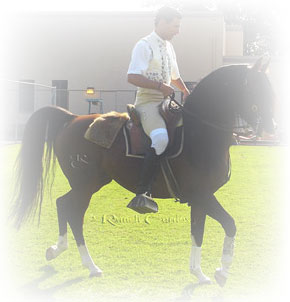The Arabian horse is generally considered to
be the world's oldest pure breed of horse and its exact origins
are to a large extent shrouded in the mists of time. Statues
and bas-reliefs from the ancient world clearly depict recognisably “Arabian
type” horses on the tombs of kings and pharoahs. What
can be certain however is that for the last few thousand years
up until the twentieth century the Arabian horse was inextricably
linked to the lives and lifestyle of the nomadic Bedouin tribes
of the Arabian Peninsula.
The combination of a harsh environment and the Bedouin's preoccupation
with purity of blood resulted in a breed of light horse ideally
suited to their needs. Characterised by dense bone, hard round
hooves, a short back, high tail carriage and a fine wedge shaped
head with large eyes and nostrils, agility and intelligence as
well as an effortless floating action. The pedigrees of the Bedouin
horses were recorded by oral tradition emphasising the descent
through female lines, in contrast with the western “stallion
orientated” approach. The main use of horses, primarily
mares, was in raiding neighbours; the demanding lifestyle resulted
in the survival of only the fittest. Foals were ridden by small
children as part of the training process.

The Bedouin traded surplus horses from time to time usually
stallions (being too noisy for raiding purposes) rather than
mares and these horses were highly sought after by all from Kings
and Potentates on down.
Rulers have always desired to be seen riding a fine horse as
a means of enhancing their own stature. This desire for outstanding
horseflesh created a vibrant market for Arabian horses in Europe
during the eighteenth century with horses being presented as
gifts or being purchased through the horse markets of the Ottoman
Empire, the horse-market in Constantinople being the largest
in the world at that time. During the seventeenth century Turkish
traders with their exotic foods, dress and Arabian horses dazzled
western society. Indeed Arabian stallions were highly prized
both as riding mounts and for breeding purposes to improve local
breeds. Well-known eighteenth century riders of Arabian horses
include George Washington (Magnolia) and Napoleon Bonaparte (Marengo).
During the nineteenth century far sighted individuals saw the
benefit of establishing their own breeding programs of Arabian
horses based on imported stock, often the initial motivation
for this was to have a constant supply of Arabian blood to upgrade
and improve the local stock, in many cases Arabian horse breeding
became the main focus of these establishments. Breeding programs
such as those established at Weil (Germany), Babolna (Hungary),
Crabbet Park (England) and Slawuta (Poland) have had a profound
impact on the Arabian horse world-wide. A major change during
this period was that people began to travel to Arabia themselves
in search of horses, rather than rely on third parties and agents
such was their disire to be certain of the purity of the horses
they obtained. One such person was an American A.Keene Richards
of Georgetown Ky who made two journeys and imported several horses
into the United States in the 1850's. He established perhaps
the first pure Arabian breeding program in North America. Sadly
his efforts were lost and scattered due to the civil war.
Modern North American Arabian horse breeding traces its roots
to the gift from the Sultan of Turkey to former President Grant
of the stallions Leopard and Linden Tree in 1878. Randolph Huntington's
mare Naomi who was imported from England being the first Arabian
mare to leave descendants who have bred on to the present day.
When bred to Leopard in 1889 she foaled Anazeh the following
year.
During the twentieth century, the Arabian horse became increasingly
more widespread throughout the world, particularly during the
last 50 years or so. Today an international community exists
united by their love and enthusiasm for the Arabian horse. The
same qualities of speed, tractability, agility, stamina and intelligence
which gave the Bedouin the ultimate war horse, are now put to
more peaceful endeavours, such as racing, endurance riding, dressage,
driving, reining, working livestock or simply trail-riding for
pleasure. For those who appreciate the unique combination of
spirit with tractability and docility with courage and intelligence
that the breed possesses, in the Arabian horse they have a riding
companion without peer.
|

